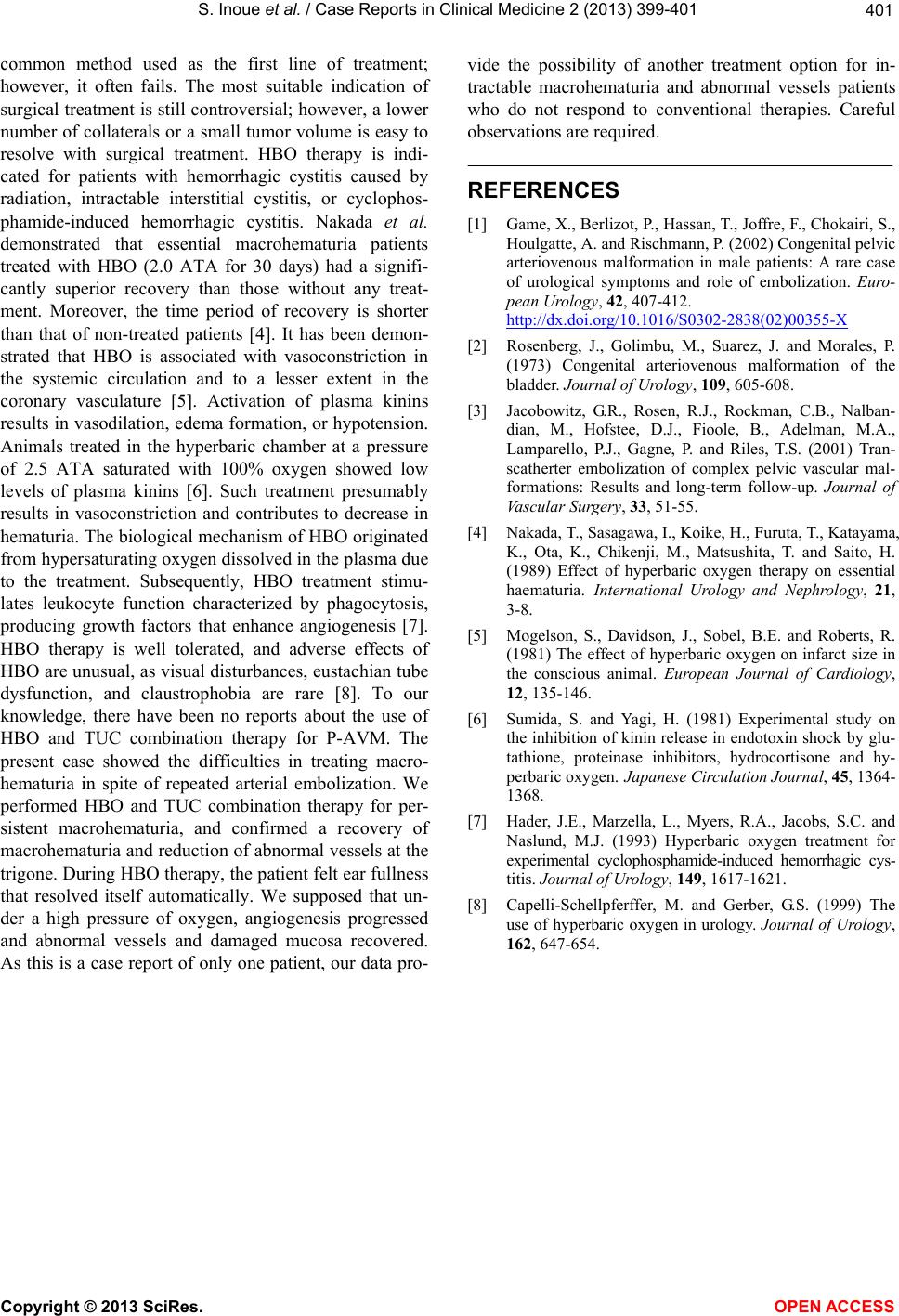
S. Inoue et al. / Case Reports in Clinical Medicine 2 (201 3) 399-401
Copyright © 2013 SciRes. OPEN ACCESS
401
common method used as the first line of treatment;
however, it often fails. The most suitable indication of
surgical treatment is still controversial; however, a lower
number of collaterals or a small tu mor volume is easy to
resolve with surgical treatment. HBO therapy is indi-
cated for patients with hemorrhagic cystitis caused by
radiation, intractable interstitial cystitis, or cyclophos-
phamide-induced hemorrhagic cystitis. Nakada et al.
demonstrated that essential macrohematuria patients
treated with HBO (2.0 ATA for 30 days) had a signifi-
cantly superior recovery than those without any treat-
ment. Moreover, the time period of recovery is shorter
than that of non-treated patients [4]. It has been demon-
strated that HBO is associated with vasoconstriction in
the systemic circulation and to a lesser extent in the
coronary vasculature [5]. Activation of plasma kinins
results in vasodilation, edema formation, or hypotension.
Animals treated in the hyperbaric chamber at a pressure
of 2.5 ATA saturated with 100% oxygen showed low
levels of plasma kinins [6]. Such treatment presumably
results in vasoconstriction and contributes to decrease in
hematuria. The biological mechanism of HBO originated
from hypersaturating oxygen dissolved in the plasma due
to the treatment. Subsequently, HBO treatment stimu-
lates leukocyte function characterized by phagocytosis,
producing growth factors that enhance angiogenesis [7].
HBO therapy is well tolerated, and adverse effects of
HBO are unusual, as visual disturbances, eustachian tube
dysfunction, and claustrophobia are rare [8]. To our
knowledge, there have been no reports about the use of
HBO and TUC combination therapy for P-AVM. The
present case showed the difficulties in treating macro-
hematuria in spite of repeated arterial embolization. We
performed HBO and TUC combination therapy for per-
sistent macrohematuria, and confirmed a recovery of
macrohematuria and reduction of abnormal vessels at the
trigone. During HBO therapy, the patient felt ear fulln ess
that resolved itself automatically. We supposed that un-
der a high pressure of oxygen, angiogenesis progressed
and abnormal vessels and damaged mucosa recovered.
As this is a case report of only one patient, our data pro-
vide the possibility of another treatment option for in-
tractable macrohematuria and abnormal vessels patients
who do not respond to conventional therapies. Careful
observations are required.
REFERENCES
[1] Game, X., Berlizot , P., Hassan, T., Joffre, F., Chokairi, S.,
Houlgatte, A. and Rischmann, P. (2002) Congenital pelvic
arteriovenous malformation in male patients: A rare case
of urological symptoms and role of embolization. Euro-
pean Urology, 42, 407-412.
http://dx.doi.org/10.1016/S0302-2838(02)00355-X
[2] Rosenberg, J., Golimbu, M., Suarez, J. and Morales, P.
(1973) Congenital arteriovenous malformation of the
bladder. Journal of Urology, 109, 605-608.
[3] Jacobowitz, G.R., Rosen, R.J., Rockman, C.B., Nalban-
dian, M., Hofstee, D.J., Fioole, B., Adelman, M.A.,
Lamparello, P.J., Gagne, P. and Riles, T.S. (2001) Tran-
scatherter embolization of complex pelvic vascular mal-
formations: Results and long-term follow-up. Journal of
Vascular Surgery, 33, 51-55.
[4] Nakada, T., Sasagawa, I., Koike, H., Furuta, T., Katayama,
K., Ota, K., Chikenji, M., Matsushita, T. and Saito, H.
(1989) Effect of hyperbaric oxygen therapy on essential
haematuria. International Urology and Nephrology, 21,
3-8.
[5] Mogelson, S., Davidson, J., Sobel, B.E. and Roberts, R.
(1981) The effect of hyperbaric oxygen on infarct size in
the conscious animal. European Journal of Cardiology,
12, 135-146.
[6] Sumida, S. and Yagi, H. (1981) Experimental study on
the inhibition of kinin release in endotoxin shock by glu-
tathione, proteinase inhibitors, hydrocortisone and hy-
perbaric oxygen. Japanese Circulation Journal, 45, 1364-
1368.
[7] Hader, J.E., Marzella, L., Myers, R.A., Jacobs, S.C. and
Naslund, M.J. (1993) Hyperbaric oxygen treatment for
experimental cyclophosphamide-induced hemorrhagic cys-
titis. Journal of Urology, 149, 1617-1621.
[8] Capelli-Schellpferffer, M. and Gerber, G.S. (1999) The
use of hyperbaric oxygen in urology. Journal of Urology,
162, 647-654.